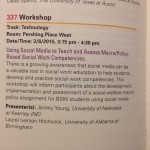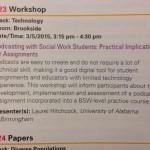Making Social Policy Relevant Through Social Media
 Dr. Casey Bohrman (@CaseyBohrman) is an assistant professor in the Department of Undergraduate Social Work at West Chester University. In this blog post, she writes about how she uses blogging tools such as Twitter and Tumblr in her social welfare policy courses to engage student in current events and practice advocacy skills.
Dr. Casey Bohrman (@CaseyBohrman) is an assistant professor in the Department of Undergraduate Social Work at West Chester University. In this blog post, she writes about how she uses blogging tools such as Twitter and Tumblr in her social welfare policy courses to engage student in current events and practice advocacy skills.
During the winter of 2013, I frequently listened to Tell Me More, an NPR radio program focused on issues impacting people of color. I noticed that many of the experts on the show came from the “blogosphere” or gained their standing through prolific tweeting. Wanting my social policy class to be relevant to modern policy discussions, I decided to have students join Twitter as part of a class assignment in Spring 2014.
Because Twitter is limited to 140 characters, I also wanted students to have the opportunity to comment on social issues in a more comprehensive fashion. Inspired by David Jaffee, a sociologist from the University of North Florida who blogs about his perspective on current socio-economic issues, I decided to have my students also create blogs. The first time I taught the class we used WordPress, as it was the site recommended to me by our librarian. In future classes, I used Tumblr as it was more user-friendly and allowed for easier incorporation of audio-visual material.
I asked students create a Twitter account and a blog about a particular area of interest, such as mental health policy or how social policy might directly impact women. I asked students to tweet several times per week and post a blog entry once a month about current issues in their policy area. I also asked them to follow a range of accounts from traditional news outlets, advocacy organization, and people directly experiencing an issue. One of the strengths of using Twitter to learn about policy is that it gives students a broader and more current perspective on an issue than they can get from a textbook. It is particularly important for social workers to hear and learn from the perspectives of people who directly impacted by a social issue. For example, there are a number of users who identify with Black Twitter (such as @Feministajones, @Karnythia, and @TheBlackVoice) who provide important perspectives on racial issues.
Lessons Learned from #SWDE2015
For those of you who missed the Social Work Distance Education Conference (#SWDE2015), hosted by the School of Social Work at the University of Indiana and the Council on Social Work Education, it was held almost two weeks ago (April 15-17, 2015) in Indianaplois, IN. I spent two days at the conference, and it is clear to me that social work educators are no longer discussing if we are going to take our courses and curricula online; the question is how are we going to do it.
After spending time talking with colleagues, listening to presentations from social workers teaching all over the country and following the #SWDE2015 comments on Twitter, I have come away with three lessons learned:
1. We need an updated research agenda in social work education that focuses on evidence-based practice for teaching. The trend to online education in social work not only raises questions about its quality and effectiveness, it should also make us re-think what we are doing in seated classrooms. For example, how do we know that face-to-face, in-class discussion actually increase social work students’ understanding and learning? Where is our evidence to support this time-honored teaching method in social work education? Or are we just more comfortable with it? As we begin assessing the quality of our pedagogies, we can start by questioning our own internal biases and assumptions about what is quality teaching and learning for our profession. Is the seated classroom the best way to teach practice skills because that is how I learned practice skills or because there is evidence to support it? From there, we can begin to develop and test meaningful research questions about the effectiveness of our teaching pedagogies. So the next time, you find yourself saying out loud that we can’t do this or that in an online classroom, stop and go to the literature or your colleagues for the evidence. If there is no evidence to be found, you have just identified your next research project.
2. We need to look and work outside our professional silos in academics. Social work education needs to turn its gaze outward. We must look to the research being done by other disciplines as they grapple with the same opportunities and challenges of incorporating technology into their pedagogies. Our colleagues in nursing, medicine, library sciences, counseling and teacher education are also teaching in online environments and are also assessing how to move their courses and curricula online. Their scholarship could help inform our own educational research agenda. We need to get out of our offices and start walking across campus to meet, talk and develop projects with other disciplines around online education. Interdisciplinary efforts and collaboration will help us get caught up with the face-paced world of online/techology-based edcuation and give us the opportunity to learn and ultimately share social work education’s unique and valuable contributions to teaching and learning in the 21st century. My own journey as a tech-savvy educator started by collaborating with a talented librarian who showed me the power of brining social media into the classroom.
3. Finally, we need to invest more in our own professional development as educators. Incorporating new and rapidly changing technology into seated and online classrooms requires new skills and knowledge that many of us did not learn during our own social work training. As individual educators, we need to assess and improve our own skills with technology and online education by reading the literature, attending institutional workshops and trainings, collaborating with colleagues and taking the leap of faith to try something new with our students. Administrators also need to support these activities and provide resources (time and money) to help us improve skills and transform content and pedagogy for online environments. And along the way, we need to help our students, alumni, community partners, and fellow social work practitioners make the transition too.
If you are interested in learning more about the #SWDE2015 Conference, please visit the website at: http://swde.iu.edu/. You will find a copy of the Conference Program, and my understanding is that videos and slideshows of some presentations will be posted soon.
Or you can also review tweets from the conference in this Storify transcript.
Please feel free to post any comments or questions for this post. I am very interested in what others have to say and continuing the conversation.
How to cite this post:
Hitchcock, L. I. (2015, April 26).Lessons Learned from #SWDE2015[Blog Post]. Retrieved from https://laureliversonhitchcock.org/2015/04/26/lessons-learned-from-swde2015/.
Follow-up to Live Twitter Chat on March 12, 2015
This is a short post to follow-up on the second live #MacroSW chat that Jimmy Young and I hosted on March 12, 2015 about the documentary Inequality for All. Once again, we had a great turnout and an inspired conversation. Others have written more about this chat, so I am going to direct you to their posts:
1. Chat Statistics: The #MacroSW Chat folks reported that there were almost 100 people on the chat who shared 640 posts in one hour. Here is a link to more analytics about the chat.
2. Chat Transcript: Here is a link to the chat transcript in Storify, a web-based program marketed as a story-telling software. It also is a great tool for summarizing tweets from live chats and other types of conversations on Twitter.
3. Chat Summary: Jimmy Young wrote a solid summary of the chat from the perspective of a social work educator. Like Jimmy, I find live Twitter chats a compelling learning tool for bachelor-level social work students. During the chats, I see students engaging in public discourse on vital policy issues with their peers and other professionals, not just in the classroom. They are actively connecting with others, sharing and thinking critically about poverty issues when participating in a live chat. Look for more information near future from Jimmy and I about using live Twitter chats in the social work classroom.
Again, many thanks to #MacroSW chat and our host from @MSWatUSC, Kristin Battista-Frazee (@porndaughter). They sponsored, promoted and summarized the chat, and are all around great people! Also, a big thanks to all the students, educators and practitioners who showed up and participated in our national conversation – including social work students and educators from University of Buffalo, University of Tennessee, University of Nebraska at Kearney University of Alabama at Birmingham, and Jacksonville State University to name a few.
How to cite this post:
Hitchcock, L. I. (2015, March 16). Follow-up to Live Twitter Chat on March 12, 2015[Blog Post]. Retrieved from https://laureliversonhitchcock.org/2015/03/16/follow-up-to-live-twitter-chat-on-march-12-2015/.
Using Social Media to teach and assess Macro/Policy-based Social Work Competencies – #BPD2015 Conference
 Today, I am pres
Today, I am pres enting with Dr. Jimmy Young at the Association of Baccalaureate Social Work Program Director’s Annual 2015 Conference (3/6/15) about our social media assignment designed for social work students to learn about and try their hand at macro- and policy-practice skills. In this workshop, we will describe how we developed, implemented and assessed this assignment which incorporates a documentary movie with a live Twitter chat. We will discuss things we learned along the way and offer tips on how other educators can incorporate a similar assignment into their courses. The learning objectives for this session include:
enting with Dr. Jimmy Young at the Association of Baccalaureate Social Work Program Director’s Annual 2015 Conference (3/6/15) about our social media assignment designed for social work students to learn about and try their hand at macro- and policy-practice skills. In this workshop, we will describe how we developed, implemented and assessed this assignment which incorporates a documentary movie with a live Twitter chat. We will discuss things we learned along the way and offer tips on how other educators can incorporate a similar assignment into their courses. The learning objectives for this session include:
1. Understand how the social media platform Twitter can be incorporated into assignments for social work policy courses at the BSW-level.
2. Demonstrate how social work educators can assess attainment of competency among BSW students using a social media assignment paired with a Rubric for evaluation of the assignment’s learning outcomes.
3. Appreciate the role of professional collaboration in the development, implementation and assessment of social media-based assignments.
We have previously written about this assignment on our blogs:
Special #MacroSW Chat October 28th at 8pm CST from JimmySW’s Blog
Follow-up to 10/28 #MacroSW Twitter Chat from Teaching Social Work Blog:
Here is a link to the Prezi that we will show during the presentation.
Our next live Twitter chat for this assignment will be on March 12, 2015 9 PM EST/8 PM CST and we invite you all to join us. The chat is sponsored by #MacroSW. Click here for more details.
Podcasting with Social Work Students – #BPD2015 Conference
I am presenting at the Association of Baccalaureate Social Work Program Director’s Annual 2015 Conference today (3/5/15) about podcasting with social work students, focusing on practical implications for course-based assignments. In this workshop, I will describe how I developed a podcast assignment for BSW students and will offer tips on how other educators can incorporate a similar assignment into their courses. The learning objectives for this session include:
1.Understanding how podcasting can be incorporated into assignments for social work courses at the BSW-level;
2. Describing how social work educators can assess attainment of competency among BSW students using a social media assignment; and
3. Appreciating the role of professional collaboration in the development, implementation and assessment using podcasting.
This presentation is based on a series of blog posts I wrote last year about podcasting in social work education:
1. Podcasting for Social Work Students, Part 1 – Describing the Assignment (1/16/14)
2. Podcasting for Social Work Students, Part 2 – Why use podcasting in the classroom (1/31/14)
Here is a link to the Prezi that I will show during the presentation (http://tiny.cc/PodcastPrezi_BPD2015).
Using Google Plus Hangouts in Social Work Education
Dr. Jandel Crutchfield is a visiting assistant professor in the Department of Social Work at the University of Mississippi. In this blog post, she writes about using Google Plus Hangouts to promote synchronous experiences in her online courses.
Until August 2014, my background in online social work education was solely in asynchronous instruction through platforms including Moodle and Blackboard. Some of the feedback from students in my courses highlighted a lack of “real” interaction with me as their professor. To address this initially, I began to record short video lectures for students to receive some another method of instruction and interaction besides text. Though this improved some student experiences, I still received feedback that students wanted more interaction with me; or that “something was missing.” Due to university regulations, however, there was little else I could do to enhance the asynchronous experience.
After joining University of Mississippi, Department of Social Work in 2014 and being offered the opportunity to teach online, I began to research ways to conduct completely synchronous session. Since many of the students had not had multiple online courses and were new to the social work department, I wanted to find a way to avoid overwhelming students with the delivery format. I found Google Plus Hangouts (which is a free video conference calling tool from Google), got it approved by the online learning department, and began learning how to use it to conduct synchronous sessions. I studied the online users’ guides from Google and activated my University Gmail account. Then I began to invite friends to participate in video calls and hangouts on air. I recorded several “test” sessions and practiced uploading them to Blackboard to view what students would see after I had shared a recording. I got feedback from my colleagues and friends that participated on the video calls and hangouts on air. I found Google Plus Hangouts to be very user friendly and integrated into larger society more than programs such as Adobe Connect or even Skype. Nearly everyone had at least heard of Google, which would facilitate usage even beyond the classroom for instructors and students alike. Also, Google Plus Hangouts did not require a license or other monitoring by the university technology department.





